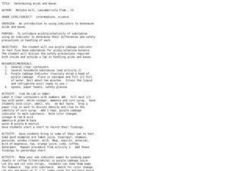LABScI
Acids and Bases: Cabbage Juice pH Indicator
Explore the range of pH using an assortment of household liquids. Scholars create their own pH indicators from cabbage and determine the pH of several liquids. To further their exploration, individuals use the same liquids to create...
American Chemical Society
Color Changes with Acids and Bases
Getting back to the beginning of the unit, learners use reactions with red cabbage juice to determine if solutions are acidic, neutral, or basic. This is a straightforward and classic investigation, but what you will appreciate is the...
Curated OER
Cabbage Juice Lab
In this acid and base learning exercise, students use cabbage juice as an indicator to test the pH of various solutions. Students complete a table with the solution name, the color red and blue litmus paper turns, the color the cabbage...
American Chemical Society
Neutralizing Acids and Bases
Now that your science class has experimented with pH indicator and identified acids and bases, they attempt to get the cabbage juice indicator back to its original color. This is done through neutralization of the acids and bases that...
Curated OER
Cabbage Juice Indicator
Students experiment with household solutions and classify them as a base or acid. In this exploratory lesson students complete a lab where they test products to see if they are an acid or a base.
California Academy of Science
Coral and Chemistry
Using cabbage juice as a pH indicator, future scientists explore the effect of increasing carbon dioxide on the pH of the ocean and relate it to the health of coral reefs. Ideal for an earth or environmental sciences course, this lesson...
Curated OER
Mystery Powder Lab
In this mystery powder instructional activity, students determine the identify of 6 unknown samples by testing them with cabbage juice for pH, vinegar, iodine for starch and heat. Students determine the identity of the mystery powders...
American Chemical Society
Powder Particulars
By both demonstration and hands-on investigation, physical science fanatics come to know that some materials react when they come together. Adding vinegar to both baking soda and to baking powder, the difference between the two is clear....
American Chemical Society
Using Chemical Change to Identify an Unknown
If you have taught the first lesson in this mini unit, learners already know that cabbage juice and vinegar cause chemical changes in some materials. Now, they get a chance to use them to compare the liquids' reactions to five known and...
Curated OER
RHS Campaign for School Indicator
Students study Ph and how acids and bases can affect it. In this indicators lesson students divide into groups and complete a lab activity to investigate what happens when they add indicators.
Curated OER
Acids, Bases and Indicators
Students investigate the pH of various solutions with indicators. In this acids, bases and indicators lesson plan, students use a variety of indicators to test solutions for their pH. Students determine which indicators are the best to...
Curated OER
Fun With Chemical Changes
Looking for a terrific chemistry lesson plan for your 5th graders? This one could be for you! After a teacher-led demonstration, learners are broken up into groups and perform an experiment using cabbage juice, water, window cleaner, and...
US Environmental Protection Agency
Corals and Chemistry
After demonstrating the use of cabbage juice as a pH indicator, have your class experiment with their own breath, exhaling into the indicator, to show that carbon dioxide is acidic. As learners work, they also watch a video about coral...
Curated OER
An Introduction to Acids and Bases
Students explore acids and bases. In this lesson about acids and bases, students do an experiment to test certain items to determine what they are. Students use cabbage and litmus paper as indicators. Students understand how to sort the...
Curated OER
Household Acids and Bases
Ninth graders complete an experiment to determine the pH values of a variety of common household substances. They use red cabbage to find the indicator colors of the pH range. They complete a data table that includes a prediction and...
Curated OER
Determining Acids and Bases
Young scholars test various liquids and identify as acids or bases. In this chemistry and pH lesson, the students use purple cabbage indicator to test a variety of teacher-provided substances, then bring in liquids from home to test...
Curated OER
Determining Acids and Bases
Students use purple cabbage indicator to test five know substances for acidic/alkaline balance. They discuss the safety precautions required both inside and outside a lab in handling acids and bases.
Curated OER
Determining pH
Students evaluate pH levels through a solubility experiment. In this pH levels lesson, students list characteristics of acids and bases. Students complete their own pH level experiment. Students go to the GEMS Alien Juice Bar website to...
Curated OER
Acids and Bases
Learners study acid and bases and how they fall on the pH scale. In this solutions lesson students complete a lob activity using litmus then fill out a data table.
Curated OER
Mixtures
Sixth graders experiment with mixtures. In this chemistry activity, 6th graders determine which mixtures are considered heterogeneous, a suspension, a solution or a colloid. Students create a data sheet of what they discover.
Curated OER
HOW IS PH DETERMINED?
Students estimate the pH based on the use of an unknown substance, determine whether an unknown substance is acid, base or neutral, and evaluate, by the pH determination, which of the unknowns is the strongest acid or base.






















